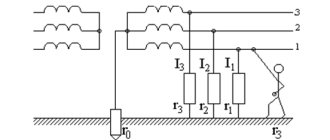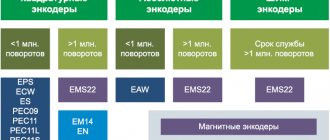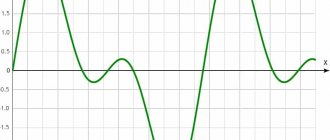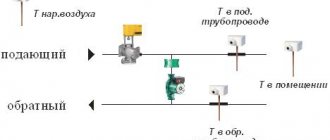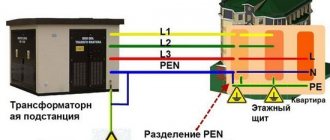Purpose of the AChR
AFR keeps the frequency characteristics in the system at a set level. If there is a drop in the power of the generated current at the power plant, using this system ensures that the most critical consumers are maintained in working order, the disconnection of which can create an emergency situation, therefore the automation disconnects unimportant connections, most often starting with category 3 consumers.
If measures are not taken in a timely manner, the entire power system may suffer as a result. For this purpose, the elements of AFR are used.
File archive ›› Automation of power systems. G.M. Pavlov, G.V. Merkuryev
The main automation devices of power systems are considered, and block diagrams of automation devices are given.
Much attention is paid to the analysis of emergency modes of power systems, explaining the principles of construction and operation of automation of normal and emergency modes
Contents 1. Automatic switching on of backup power and equipment 2. Automatic restarting 3. Generator synchronization 4. Generator voltage regulation 5. Frequency and active power regulation 6. Emergency frequency unloading 7. Emergency loading of power plants8. Automatic termination of asynchronous movement
Separation of consumers by categories
Classification of categories:
- Consumers are divided into categories based on importance. Disabling equipment of the first category can pose a danger to human life.
- Problems with consumers of the second degree of importance can negatively affect the production cycle of industrial enterprises, causing serious material losses.
- The third category does not imply serious consequences in the event of a blackout and is accepted as a priority for shutdown in the event of an emergency.
Design and principle of operation
The figure below shows the AFR response circuits, which assume the use of frequency automatic reclosure:
Also read: How many watts are in one kilowatt
If the frequency drops below the set value, the KF frequency relay is activated. Next, the signal is transmitted to the temporary relay KT1 with the contacts closing on the intermediate group relays KL1 and KL2. This is how the power supply to consumers is controlled according to the established priority.
The frequency characteristics of the system are then checked using a measuring element. As soon as the frequency reaches the standard value of 50 Hz, a start command is sent to the measuring module through temporary CT2. Next, using the intermediate KL4, the contacts are closed to reconnect the equipment.
Classification
Power plants and substations are equipped with various AFR systems, which provide for the use of one of four protections or the simultaneous operation of several of them. The classification includes the following types of these elements:
- AFC1 (first) – shutdown is carried out within half a second, with the trigger settings in the event of a frequency drop of 1.5 to 3.5 Hz from the nominal one. The range value can be adjusted in 0.1 Hz steps. Consumers are switched off in stages, depending on power characteristics;
- AFR2 (second) – frequency parameters are similar, but the time interval increases from 5 to 90 seconds;
- ZAChR – designed for use in nuclear power plant conditions. The time interval is set to trigger within 0.5 seconds;
- CHAPV – with frequency automatic restart.
These elements can be used individually or in combination.
File archive ›› Fundamentals of power system automation. M.A. BERKOVICH, A.H. KOMAROV, V.A. SEMENOV
The purpose and scope of application of the main technical means of automation of power systems are considered. Schematic diagrams and descriptions of the principles of operation of automatic reclosure, automatic reclosure, automatic reclosure, automatic frequency control, automatic synchronization and emergency control devices are provided. Methods for calculating the settings of automation devices are outlined. The first edition was published in 1968. The second edition examines new equipment. For engineers and technical workers involved in the design and operation of system automation devices. Can be used by university and technical college students.
AFR schemes
According to established standards, AFRs may provide for the performance of various protective functions. The circuits involve the use of relay and semiconductor elements.
With one frequency relay
The diagram below shows an element with one frequency relay:
The command is sent from the measuring module through the intermediate relay RP to frequency RF1.
When the frequency parameters drop, RP1 and RP2 are closed, from the latter the signal is transmitted to turn off the power supply.
Also read: Automatic reclosing - automatic reclosure
If the frequency is restored to the standard value, the circuit returns to its original state. Through RP5, the command is sent to RP5.1, with the coils PB1 and RP4 turned off.
If the operation of the system according to the specified scheme turns out to be impossible, PB1 is shunted.
WITH CHAPV
Automatic frequency unloading assumes the following scheme:
The order of operation of relay protection is similar to the previous example. Through P4, the command is transmitted to the time relay PB1, with the excitation of the windings on the intermediate RP1.
Through RP1.1 and RP2.1 the system is turned off. Signaling about this is provided by RU1.
When the situation normalizes, current is supplied through RP1.3 and RP3.2 to winding PB2, with the relay of the intermediate group RP4 turned on. Next, with the help of RP4.2 and RP 4.3, consumers are started, with signaling from the indicator relay RU2.
List of used literature
- Rabinovich R.S. “Automatic frequency unloading of power systems” 1989
- Aleksandrov V.F., Ezersky V.G., Zakharov O.G., Malyshev V.S. “Digital frequency shedding devices” 2005
- Krivenkov V.V. "Anti-emergency automation" 2004
- Rozhkova L.D., Kozulin V.S. “Electrical equipment of stations and substations” 1987
- Chernobrovov N.V., Semenov V.A. “Relay protection of energy systems” 1998
- G. M. Pavlov, A. G. Merkuryev “Emergency frequency unloading of power systems. Training manual" 1998
Requirements
To ensure normal operation, the AFR must meet the following requirements:
- successfully eliminate emergency situations of various types - triggering, regardless of the extent of the damage;
- perform a shutdown in accordance with the established settings for time and the magnitude of the characteristics deviation;
- de-energize the minimum number of consumers;
- provide for the possibility of stepwise shutdown;
- exclude spontaneous operation without appropriate grounds.
The listed conditions are intended to ensure normal operation of the equipment and its proper protection.
Consequences of reducing frequency
If the frequency in the network decreases by up to 0.4 Hz, this situation will not significantly affect the operation of the equipment. But if the frequency characteristics drop by 2 Hz or more, this can lead to irreversible processes, both in the power grid itself and in the operation of consumers.
Also read: How many electrical safety clearance groups are there?
If the response is insufficient, the situation can develop unpredictably, even leading to serious accidents. As a result, the operating mode of the equipment is disrupted, with the risk of overheating of the machines and damage to the insulation, leading to their failure.
The use of AFC allows you to automatically turn off the system in case of significant frequency deviations from the nominal value, preventing the creation of an emergency situation.
Requirements for automatic frequency shedding
The amount of power applied to the AFR must be sufficient to eliminate the power shortage.
The AFR device should help avoid the occurrence of a “frequency avalanche”.
It is necessary to fully comply with the disconnected load to the value of the power deficit.
After the AFC is triggered, the frequency value must return to the previous standard frequency value or to a value of at least 49 Hz.
A short-term decrease in the frequency value should not lead to the operation of AFC devices.
In addition to automatic frequency unloading of categories I and II, additional unloading exists and is used; it serves to perform local unloading when the shortage of active capacities appears too high, when both AFC capacities of categories I and II are clearly insufficient to prevent the emerging shortage.

